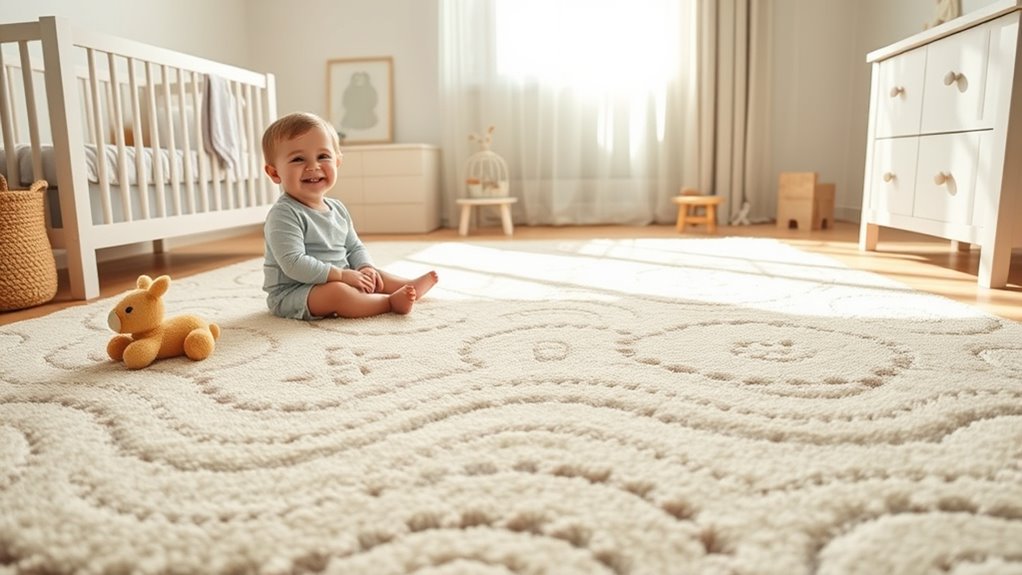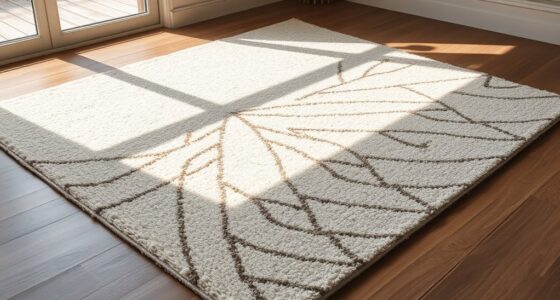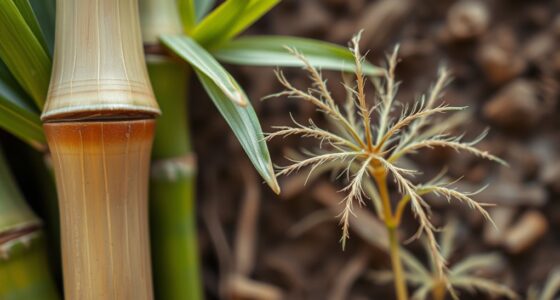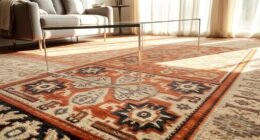When choosing non-toxic rugs for child-friendly spaces, focus on natural fibers like wool, cotton, jute, or sisal, which are free from harmful chemicals and VOCs. If you opt for synthetic options, look for eco-friendly certifications such as OEKO-TEX or Green Label Plus, and avoid rugs with strong chemical odors. Prioritize rugs with safe backing and maintain cleanliness to keep the area healthy. Keep exploring to discover more tips for creating a safe environment.
Key Takeaways
- Prioritize natural fiber rugs like wool, cotton, jute, or sisal for safer, chemical-free options.
- Check for certifications such as OEKO-TEX or Green Label Plus to ensure low chemical emissions.
- Avoid rugs with strong chemical odors and choose those made with non-toxic dyes and eco-friendly manufacturing.
- Opt for rugs with non-toxic backing materials for added safety and reduced chemical exposure.
- Regularly clean and maintain rugs to prevent mold, stains, and maintain a healthy environment for children.

When selecting a rug for your home, ensuring safety by choosing non-toxic options is vital. Your child’s health depends on the materials you pick, especially in spaces where they play, crawl, and spend a lot of time. One of the most important factors is the fiber content. Natural fibers like wool, cotton, jute, and sisal are excellent choices because they’re generally free from harmful chemicals and VOCs (volatile organic compounds). These materials are biodegradable, breathable, and tend to emit fewer toxins, making them safer for children. Plus, natural fibers often have a softer, warmer feel underfoot, which is perfect for creating a cozy environment.
Choose natural fiber rugs for safer, softer, and healthier spaces for your children.
On the other hand, synthetic alternatives are widely available and can be attractive due to their durability and affordability. However, many synthetic rugs are made from plastics like nylon, polyester, or olefin, which can off-gas chemicals such as formaldehyde and phthalates. These substances may pose health risks, especially to little ones with sensitive lungs or skin. When choosing synthetic options, look for rugs labeled as low-VOC or those that meet strict safety standards. Some synthetic rugs are now manufactured with eco-friendly processes and contain fewer harmful chemicals, but it’s essential to read labels carefully. Avoid synthetics with a strong chemical smell, as this indicates the presence of volatile compounds that could be harmful over time.
If you prefer synthetic options, seek out rugs with certifications from organizations like Green Label Plus or OEKO-TEX Standard 100. These labels indicate that the product has been tested for harmful substances and meets safety standards. While natural fiber rugs are generally safer, they may require more maintenance to prevent mold or stains, especially in high-traffic areas. Synthetic rugs often resist stains and are easier to clean, but you should still ensure they’re made with non-toxic dyes and backing materials. Additionally, understanding the potential health risks associated with certain materials can help you make more informed choices for your family.
Ultimately, the safest approach is to prioritize natural fibers for children’s spaces whenever possible. They’re a healthier choice and create a more inviting, safe environment. If you opt for synthetic, do your research, choose eco-friendly options, and look for reputable certifications. This way, you can strike a balance between durability, safety, and environmental responsibility, ensuring your home remains a safe haven for your little ones.
Frequently Asked Questions
Are Natural Fibers Always Safer Than Synthetic Options?
Natural fibers aren’t always safer than synthetic options because fiber durability varies. Some natural fibers like wool are durable and hypoallergenic, making them good for children’s spaces. However, certain synthetics are treated to be non-toxic and safe, offering durability and stain resistance. You should consider each material’s safety profile, fiber durability, and potential allergens when choosing a rug. Ultimately, look for options that balance synthetic safety with natural fiber benefits.
How Do I Verify a Rug’s Non-Toxic Claims?
To verify a rug’s non-toxic claims, first, channel your inner Sherlock and check for reputable chemical certifications like GOTS or OEKO-TEX. These badges confirm the rug meets strict safety standards. Additionally, seek transparency in manufacturing practices—ask for detailed info on dyes and treatments. Trust brands that willingly share their processes; it’s a sign they prioritize your child’s health over a quick profit.
Do Non-Toxic Rugs Stain or Wear Out Faster?
Non-toxic rugs generally don’t stain or wear out faster if you choose quality options. Look for rugs with stain resistance features and durable fibers, as these help maintain their appearance over time. While some eco-friendly materials may be less resistant initially, many modern non-toxic rugs are designed to be just as durable as conventional ones. Regular cleaning and proper care also extend their lifespan, ensuring they stay safe and attractive for your space.
Are Non-Toxic Rugs More Expensive Than Conventional Ones?
Non-toxic rugs are generally more expensive than conventional ones due to eco-friendly materials and safer dyes. When you compare costs, you’ll find that the initial investment might be higher, but many parents consider the health benefits worth it. Affordability considerations include weighing these costs against potential health care savings and peace of mind. Ultimately, you may find that the added safety features make non-toxic rugs a worthwhile investment for your child’s space.
Can Non-Toxic Rugs Be Washed Easily?
Think of your non-toxic rug as a trusty shield for your child’s playroom. You’ll find cleaning tips easy to follow, especially since many are machine washable. Just be mindful of colorfastness concerns—use gentle detergents to prevent fading. Regular vacuuming and spot cleaning keep it fresh. So yes, non-toxic rugs can be washed easily, making them perfect for busy, child-friendly spaces.
Conclusion
By choosing non-toxic rugs, you create a safer, healthier space for your little ones. Imagine a family who switched to eco-friendly, chemical-free rugs and noticed their child’s allergies improving. Making these mindful choices not only protects your child’s health but also supports a sustainable environment. So, next time you’re shopping for a rug, remember: your conscious decision can make a big difference in your child’s well-being and happiness.









